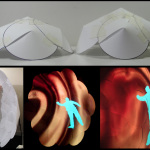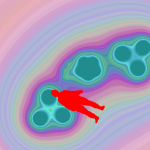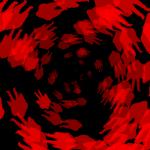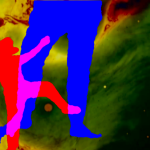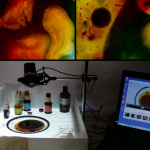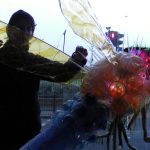- Dome construction experiments, Genetic Moo
- Interactive animation experiments, Genetic Moo
- Interactive animation experiments, Genetic Moo
- Interactive animation experiments, Genetic Moo
- Background footage tests, Genetic Moo
- The 4ft horsefly construction, Genetic Moo
How we are making the film, The Battle of Blister
We are creating code-driven animations which we will display in interactive video spaces. Footage will be gathered in two ways:
1. The animations will be programmed to self-document
2. We film people engaging with them
This will be done at a series of events we are hosting called ‘Blister Cinema’. We’ll be running three Blister Cinemas between February and July 2015 – details here.
Project development with Dr Neil Dufton
Together with our scientist, Dr Neil Dufton, we have developed the narrative, which follows the journey of a pathogen, from the mouth of a horsefly into a human body. This focus on an infected blister led us to the idea of the Blister Cinema – an immersive interactive environment.
We have identified the key stages in the inflammation process: infection; inflammation and resolution and identified the key agents (our characters): bacteria, mast cells, histomines, neutrophils, leukocytes and the endothelial cells.
As we are creating interactive animations we have been discussing and experimenting with possible interactions. We will be using Kinect technology which enables full body engagement and multiple user interaction.
Preparing for our Blister Cinema events
Our Dome technology advisor, Dr Nick Lambert, has guided us through purchasing suitable projectors, working with half dome mirrors and 360 degree filming.
With the technology in place, Nicola has been experimenting with constructing dome projection surfaces for our first Blister Cinema and has settled on a Randome construction invented by Dick Fischbeck. Not only is it easier to build than the more conventional geodesic dome it’s a lot cheaper. We’re using 4mm corrugated plastic, plastic bolts and wing nuts – this means we can recycle the domes for future Blister Cinemas.
We’ve done some basic projection tests so the next stage is very important. We’ll be resident artists in the Panay Fashions building in Margate over February and this will give us plenty of opportunity to develop our dome building and projection skills, as well as test run the interactive animations that Tim’s been developing. The residency will culminate in a three day exhibition as part of GEEK 2015 (Games Expo East Kent), where we’ll also be running some workshops.
We are designing between 15 and 20 interactive animations that each focus on a specific stage in the inflammation process. These animations will encourage the audience to embody the different cells involved in the process, even the pathogen. Overall we are looking to physicalise the processes that go on so that humans can feel involved in and learn more about the science. Tim’s been experimenting with a number of fluid dynamic computer simulations to work out the best way to represent different environments in the body, such as the blood vessels, endothelium and blister. These simulations have included Metaballs, Brownian motion, springs and particle systems.
We’ve also set up a small liquid light film set to capture Nicola’s chemical experiments. Oil, water and alcohol, with drops of water-based or oil-based colours create beautiful swirling organic landscapes. We plan to use the liquid light films as backgrounds to some of the interactive animation sequences. We’ve already done a few tests to see how the two very different aesthetics of Kinect silhouettes and liquid light work together, and it looks promising.
To help promote Blister Cinema 1 we built a 4ft horsefly, this is happily sitting in the front window of the Panay Fashions building and when the sun goes down it lights up with a pulsing LED light system of blue, red and green.
Blister Cinemas
As well as being exhibits, our Blister Cinemas will act as film sets. We’re looking forward to filming both spontaneous and rehearsed engagement with our interactive animations.
Each Blister Cinema will have a certain character: BC1 will involve simple game like interactions bacteria vs host (befitting a game expo); BC2 will involve more advanced collaborative interactions and BC3 will culminate in a battle with invited groups (hopefully including scientists and a gymnastic squad) developing interactive performances for filming.
Genetic Moo, January 2015


